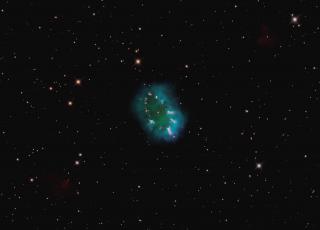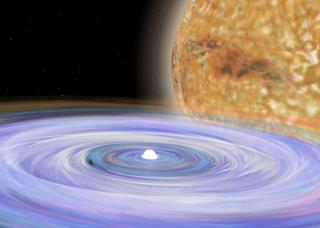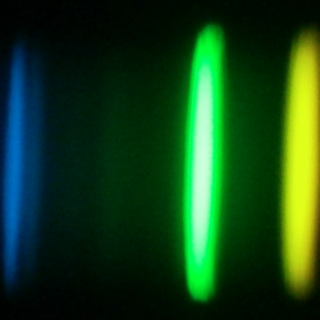Bibcode
Corradi, R. L. M.; Rodríguez-Gil, P.; Jones, D.; García-Rojas, J.; Mampaso, A.; García-Alvarez, D.; Pursimo, T.; Eenmäe, T.; Liimets, T.; Miszalski, B.
Bibliographical reference
Monthly Notices of the Royal Astronomical Society, Volume 441, Issue 4, p.2799-2808
Advertised on:
7
2014
Citations
32
Refereed citations
27
Description
While analysing the images of the IPHAS (INT/WFC Photometric Hα
Survey of the northern Galactic plane) survey, we noticed that the
central star of the candidate planetary nebula IPHASXJ211420.0+434136
(also named Ou5) was clearly variable. This is generally considered as
an indication of binarity. To confirm it, we performed a photometric
monitoring of the central star, and obtained images and spectra of the
nebula. The nebular spectrum confirms that IPHASXJ211420.0+434136 is a
planetary nebula of moderately high excitation. It has a remarkable
morphology with two nested pairs of bipolar lobes and other unusual
features. The light curve of the central star reveals that it is an
eclipsing binary system with an orbital period of 8.74 h. It also
displays a strong irradiation effect with an amplitude of 1.5 mag. The
presence of multiple bipolar outflows adds constraints to the formation
of these nebulae, suggesting the occurrence of discrete ejection events
during, or immediately before, the common-envelope phase.
IPHASXJ211420.0+434136 also adds evidence to the hypothesis that a
significant fraction of planetary nebulae with close binary central
stars have a peculiar nebular chemistry and a relatively low nebular
mass. This may point to low-mass, low-metallicity progenitors, with
additional effects related to the binary evolution. We also suggest that
these objects may be relevant to understand the abundance discrepancy
problem in planetary nebulae.
Related projects

Bipolar Nebulae
This project has three major objectives: 1) To determine the physico-chemical characteristics of bipolar planetary nebulae and symbiotic nebulae, to help understanding the origin of bipolarity and to test theoretical models, mainly models with binary central stars, aimed at explaining the observed morphology and kinematics. 2) To study the low
Antonio
Mampaso Recio
![Izquierda - Imagen RGB de la nebulosa de Orión y M43 obtenida filtros estrechos con la cámara WFC en el INT: H alfa (rojo), [S II] 6716+30 (verde), [O III] 5007 (azul). Derecha - Imagen en falso color de la nebulosa planetaria NGC 6778. En azul se ve la emisión en la línea de O II tomada con el filtro sintonizable azul del instrumento OSIRIS en el GTC; en verde imagen con el filtro estrecho de [O III] del Nordic Optical Telescope (NOT). Izquierda - Imagen RGB de la nebulosa de Orión y M43 obtenida filtros estrechos con la cámara WFC en el INT: H alfa (rojo), [S II] 6716+30 (verde), [O III] 5007 (azul). Derecha - Imagen en falso color de la nebulosa planetaria NGC 6778. En azul se ve la emisión en la línea de O II tomada con el filtro sintonizable azul del instrumento OSIRIS en el GTC; en verde imagen con el filtro estrecho de [O III] del Nordic Optical Telescope (NOT).](/sites/default/files/styles/crop_square_2_2_to_320px/public/images/project/imagen_web.jpg?itok=fsBmV9CO)
Physics of Ionized Nebulae
The research that is being carried out by the group can be condensed into two main lines: 1) Study of the structure, dynamics, physical conditions and chemical evolution of Galactic and extragalactic ionized nebulae through detailed analysis and modelization of their spectra. Investigation of chemical composition gradients along the disk of our
Jorge
García Rojas

Binary Stars
The study of binary stars is essential to stellar astrophysics. A large number of stars form and evolve within binary systems. Therefore, their study is fundamental to understand stellar and galactic evolution. Particularly relevant is that binary systems are still the best source of precise stellar mass and radius measurements. Research lines
Pablo
Rodríguez Gil

Chemical Abundances in Stars
Stellar spectroscopy allows us to determine the properties and chemical compositions of stars. From this information for stars of different ages in the Milky Way, it is possible to reconstruct the chemical evolution of the Galaxy, as well as the origin of the elements heavier than boron, created mainly in stellar interiors. It is also possible to
Carlos
Allende Prieto